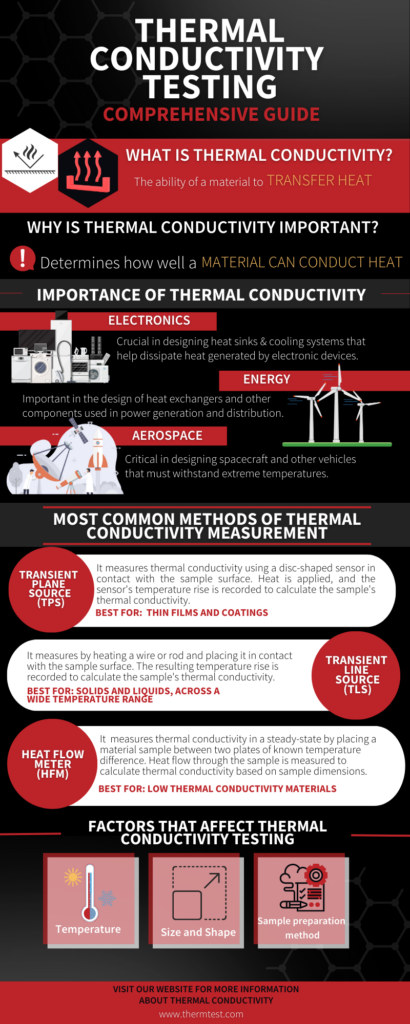
May 17, 2023
The goal of the Exploring Thermal Conductivity blog series is to provide educational support, arming you with the knowledge you need to navigate the latest industry innovations so that you can make the best possible decision for your business or product. Thermal conductivity is the ability of a material to transfer heat. Knowing the thermal conductivity of a material is vital throughout a wide range of industries, including manufacturing, construction, technology, aerospace and even the medical industry.
In this article, we will clear up any confusion surrounding thermal conductivity testing, including the different methods of measuring thermal conductivity and the factors that can affect the accuracy of these measurements. At the end of the article, there is an infographic that you can use as a quick reference guide.
Thermal conductivity is important because it determines how well a material can conduct heat, one of the critical components to designing thermal management systems for various applications. For example,
There are several methods for measuring thermal conductivity, but for now, we’ll focus on three of the common methods: transient plane source (TPS) method, transient line source (TLS) method, and the heat flow meter (HFM) method.
In this method, a disc-shaped sensor is placed in contact with the surface of the sample material (what you want to test). Heat is then applied to the sensor, and the resulting temperature rise is recorded. The thermal conductivity of the sample is calculated based on the rate at which the temperature of the sensor returns to its initial value.
This method is easy to use and requires any size sample of material. TPS is also well-suited for measuring the thermal conductivity of thin-films and coatings.
In the transient line source (TLS) method, a probe is heated by passing a current through it. The probe is then placed within the sample material, and the resulting temperature rise is recorded. The thermal conductivity of the sample is calculated based on the rate at which the temperature of the probe returns to its initial value.
The TLS method is well-suited for testing soils, polymers and soft rocks, as well as liquids in some applications. It can also measure thermal conductivity over a wide range of temperatures.
The heat flow meter (HFM) method is a steady-state method for measuring thermal conductivity. In this method, a sample of material is placed between two plates of known temperature difference. The rate of heat flow through the sample is measured, and the thermal conductivity of the sample is calculated based on the heat flow rate and the sample’s dimensions.
The HFM method is relatively simple to use and can provide accurate results for materials with low thermal conductivity and is well suited for insulative construction materials.
Several factors can affect the accuracy of thermal conductivity testing including.
Understanding how these factors can influence your results as much as possible is integral to ensuring accurate and reliable results.
Thermal conductivity is an important property of materials that determines their ability to transfer heat. Measuring thermal conductivity is critical in designing thermal management systems across a variety of industries and applications. The transient plane source, transient line source, and heat flow meter methods are common techniques used to measure thermal conductivity and thermal resistence, each with its own advantages and disadvantages. Remember, it’s important to control the variables and factors that can affect the accuracy of thermal conductivity testing to establish reliable results.

“Introduction to Thermal Conductivity.” AZoM.
https://www.azom.com/article.aspx?ArticleID=17414.
Raghavan, V. R., and W. Y. Lee. “Handbook of Thermal Analysis and Calorimetry, Volume 1: Principles and Practice.” Journal of Thermal Analysis and Calorimetry 77, no. 1 (2004): 344-45. doi:10.1023/b:jtan.0000034446.09807.ee.